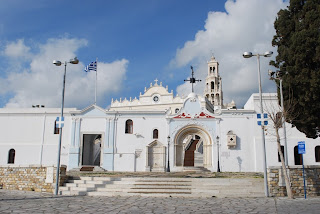


I am just back from the first optional trip of the year, which this year was a joint trip with the American Academy at Rome to Sicily. As such, we had not one, but two Mellon Professors to shepherd us, Corey Brennan, Margie's opposite number in Rome, helping us cause chaos and mayhem wherever we went. Alas, though, no internet access was to be had, so, rather than a blow-by-blow account, I have just included some of the highlights below.
Perhaps the highest was the very first site we visited, the Cappella Palatina in Palermo, which has some of the finest Byzantine Mosaics surviving anywhere in the world. Built by the norman king, Roger II (1095-1154), it is a fine token of the vibrant and prosperous city of the time.
The main apse
Eve is born of Adam
Or Selinus, the largest archaeological park in Europe, containing multiple temples and sanctuaries, including the largest temple surviving in the Doric order, merely c 100m by 50m (yes, except Agrigento, but that had partly engaged columns). The capitals have to be seen (and climbed) to be believed. Getting up, though, was sometimes much easier than getting down.
Now, how did I get up here?
Temple G overview
An offering to Demeter Maleophorus
Unfortunately, because of the recent rains, we could not visit all the sites on our itinerary, but there were some unexpected treats, such as running into Malcolm Bell, the excavator at Morgantina, who proceeded to give us an impromptu tour of the site. and, of course, the food. The Food! We were fortunate to have several afficionadoes among us, who scouted out Slow Food accredited restaurants as we went; and, when we were in a hurry, there was no shortage of markets to raid for lunch. Mmm...
Cakes from Noto

